Text
Guys i just finished my first draft of my masters project (trains in space [working title]) and my thoughts r buzzing but like
Would u guys like to see my space train design so far
78 notes
·
View notes
Text
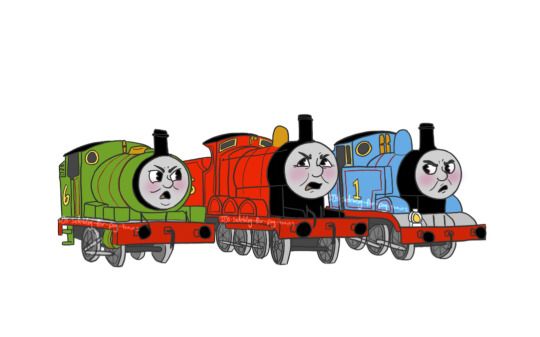
I present: 1x5x6, OR The Worst Polycule Ever (TM) /fond
Don't worry about all the arguing. That's how they all bond and flirt.
(I was gonna draw more but i got eepy)
#ttte art#ttte percy#ttte james#ttte thomas#ttte shipping#polycules should also allowed to be boomer marrieds <3
65 notes
·
View notes
Text
@togetherness23 @djs-sideblog-for-pog-trains I can't recall if you've made note of any of this before, but I figure this whole post is up your alleys 🎵
Musical musings - TTTE edition
One of the things that got me back into TTTE was the banger soundtrack and character themes. Music has always been a huge part of my life, I have classical training for the piano and an in-depth knowledge of musical theory and harmonic practices for classical music. So here are some of the things I noticed about various character themes and some of the engines' whistles.
Gordon is considered to be the biggest engine out of the main 12, and this could be reflected in his whistle, as it has the greatest interval between the two notes which make it up, that being a minor seventh between C and Bb.
James' whistle (G - C#/Db) is a tritone/Augmented 4th/Diminished 5th. In medieval times, this interval was considered to be a representation of conflict, discord (no, not THAT Discord) instability and danger. You can hear it in pieces like the iconic opening to Camille Saint-Seans' Danse Macabre, and in Hector Berlioz's La damnation de Faust to represent the titular character's arrival in Hell. James, I've noticed, is pretty damn insecure. He clings to his red paint like a lifeline and hides behind a veneer of arrogance and vanity. He can be quite boastful, to the detriment of his relationships with other engines, with him usually being the aggressor in conflicts with them. So I suppose the use of a tritone for his whistle is appropriate.
Percy appears to (mentally) be the youngest of the main 12, and this could be represented by having the highest whistle out of all of them.
Thomas' character theme and Edward's Series 2 theme both feature modulations to the parallel major of the initial key's relative minor, with Thomas' theme starting in F major and ending in D major, and Edward's theme starting in C major and ending in A major. The "relative minor" of a major key is the minor key which shares its key signature (ex. the relative minor of F major is D minor since they share the same key signature of one flat, likewise with C major, A minor and a key signature of no accidentals). The "parallel major" of a minor key is the major key which shares its 1st note (AKA, the tonic). So....like mentor, like mentee. Or like Father, like Son, in terms of musical themes.
Henry's theme is in a quadruple meter (following an 8-measure phrasing pattern, likely 12/8 time), meaning that there are 4 beats to a measure. However, each one of these "beats" consists of a triplet(If you were to count out a measure, it'd be 1-2-3 4-5-6 7-8-9 10-11-12, and you'd conduct it like 4 beats instead of each of the 12 individual notes) And Henry is the number 3 engine. Hmm.......
If I think of any more, I'll post 'em. If anyone even reads this lol
P.S: One of my favourite OSTs is Kingdom Dance from Tangled, and every time I listen it, I think of the twins. Probably because it uses the E Dorian mode (with a dash of E Mixolydian) which is common in Scottish music. Just in case anyone's confused, the "Dorian" mode is an 8-note scale which starts on the second note of a given major scale. (e.g, E is the 2nd note of a D major scale, so its Dorian mode uses the same signature of 2 sharps). The Mixolydian mode is an 8-note scale which starts on the 5th note of a given major scale. (e.g, E is the 5th note of an A major scale and thus, its Mixolydian mode uses the same key signature of 3 sharps).
youtube
72 notes
·
View notes
Text
I-I'm sorry but I can't stop thinking about this
182K notes
·
View notes
Text
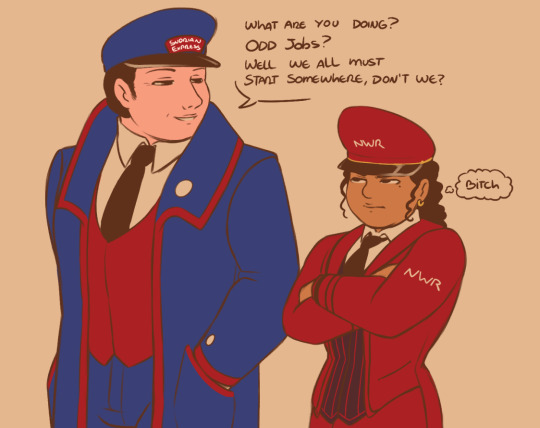

quick something for (almost late) 4/5
Thank you @/togetherness23 for reminding me of how much I love James and Gordon's dynamic in James and the Express
137 notes
·
View notes
Text
Bulleid's Proposed Locomotives
So it turns out Bulleid had so many of his designs dropped for one reason or another, and since I can't stick with a single project for more than a few seconds, I wrote up histories for all of them!
Enjoy the ramblings of a madman who spent a good long while finding free number slots for them.
Southern Railway Warship Class
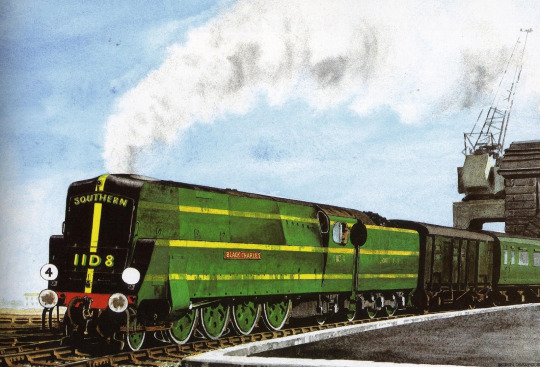
The Southern Railway was the most financially successful of the "Big Four", but this was largely based on investment in suburban and main line electrification. After the successful introduction of the SR Schools class in 1930, the railway had lagged behind the others in terms of modernizing its aging fleet of steam locomotives, as they were more focused on Electrification. Following the retirement of the general manager of the Southern Railway Sir Herbert Walker and Richard Maunsell the Chief Mechanical Engineer (CME) in 1937, their successors considered that the time had come to change this situation. In March 1938 the new general manager Gilbert Szlumper authorized Oliver Bulleid, Maunsell's replacement, to prepare designs for twenty express passenger locomotives. The deteriorating international situation prior to the Second World War was an additional factor in this decision.
Originally, Bulleid had wanted a 4-8-2 Mountain Type, but the Civil Engineering department had resisted this based on size and weight, so a 2-8-2 was chosen instead. Bulleid had worked with Gresley on his P2 2-8-2 express engines, so he already had some background knowledge, especially with the P2’s problems and ideas on how to solve them. Of course, due to the war, they were classified as heavy mixed-traffic engines to get around wartime regulations.
They were built with high-pressure 280 PSI boilers and three 18inx26in cylinders, as well as being the first engines to use Bulleid’s chain-driven valve gear, though the middle cylinder had to be inclined steeply to clear the first driven axle. The boiler was partly welded to save on cost, and the inner firebox was made of steel. The Southern had no facilities to build these boilers, so it was subcontracted to the North British Locomotive Co., as well as Beyer Peacock. They were also fitted with Bulleid’s Air-Smooth Casing. Unlike later designs that utilized this, the casing on the Warships both served their function purpose as labor saving as well as being able to be passed off as some sort of streamlining. How Bulleid got that one through during the war is a mystery! The Warship’s were also the first to use Bulleid’s Firth-Brown Wheels.
10 of these engines were constructed in 1940. More were set to be produced, but once again, the Civil Engineering Department expressed their discomfort at such a large engine running at high speeds with only a single pony-truck in front, despite other engines of a similar design getting on fine elsewhere. This would lead Bulleid to designing and building 30 of his well-known Merchant Navy Class 4-6-2s.
They were named after Warships as a way to increase morale, with 11D1 being officially named “Dreadnought” in April 1940. They performed well in service, hauling heavy passenger and express goods, though the Chain-Driven valve gear was sensitive and required high maintenance, as well as the oil-bath having leaking problems, contributing to wheel-slips(Though the extra wheel helped negate this as well). The casing, while it did save on labor during cleaning, and the more streamlined appearance helped with publicity, it made maintenance hard to carry out. Surprisingly, thanks to their different front ends, they never really experienced drifting smoke like Bulleid’s Pacifics.
All 10 of the engines would be passed into British Railways, numbered 37001-37010, where their duties mostly stayed the same. 11D8 “Black Charles'' took part in the 1948 locomotive exchange trials, where it was compared to LMS Duchess pacifics and LNER A4’s and A2/2s, where it performed favorably, though the chain driven valve gear and its oil bath still caused headaches. After the Crewkerne incident, BR chose a rebuilding program of any engines that still used Bulleid’s Chain Driven motion, however, as the Warships had required far less modifications that the Pacifics, they were on the bottom of the list in the rebuilding program. In the end, only 37003 “Triumph”, 37009 “Warspite”, and 37010 “Exeter” were rebuilt in 1956, 1957, and 1959.
Despite their status as a class with very few engines, all ten would survive until the end of southern steam, going between 1965-1966.
Two are preserved, both being rescued from Barry Scrapyard in Wales. These examples are Class Pioneer 11D1 “Dreadnought”, as well as 11D3 “Triumph”.
Stats
Power Classification - 8MT
Built - 1940 to 1941
Boiler Pressure - 280 PSI
Cylinders (3) - 18in x 26in
Wheels (Driven) - 6ft 2in
Wheels (Leading) - 3ft 1in
Wheels (Trailing) - 3ft 7in
Wheels (Tender) 3ft 7in
Tractive Effort - 40,640 lbf
Total Length - 74ft 8in
Fleet
11D1 (37001) - Dreadnought
11D2 (37002) - Anson
11D3 (37003) - Triumph
11D4 (37004) - Vanguard
11D5 (37005) - Ark Royal
11D6 (37006) - Audacity
11D7 (37007) - Valiant
11D8 (37008) - Black Charles
11D9 (37009) - Warspite
11D10 (37010) - Exeter
Southern Railway Prototype Light Pacific
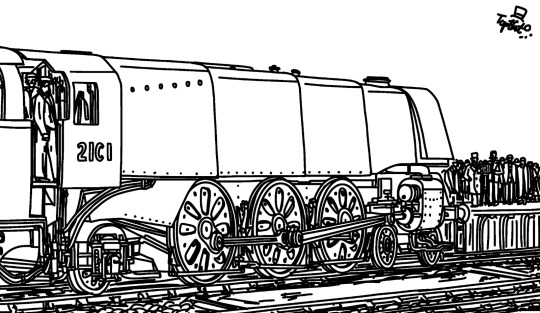
(Pic by Sttophat on twitter)
In 1941, Bulleid had introduced his Warship Mikado's and Merchant Navy Pacific's to become the main motive power for the Southern Railway’s Express passenger trains, though while they performed well, they were restricted by their weight, especially since the condition of the rails were hampered by the Second World War. Initially, trains on the lighter sections were handled by the Q1 0-6-0 freight engines and other, older engines, but they couldn’t handle the faster trains that were anticipated after the war. There was also the planned electrification of certain areas after the war, so the new design also needed to handle freight traffic as well, fast enough to not impede electric services.
What was decided on in the end was a downsized version of the Merchant Navy’s, fitted with the same design theory of the Q1’s to create a “Light Pacific”. The Locomotive was completed in 1942 alongside the Q1’s, and was trialed for a short time before entering service. It was deemed a success, and numbered 21C201. It was powerful enough to handle fast, heavy trains, as well as having an extremely light axle loading for a pacific at 16.5 Tons, enabling it to be used on almost every part of the UK Network as a whole. However, Bulleid decided to go with a different approach, creating simply a downsized Merchant Navy with no Q1 elements. This would increase the axle load, though this wasn’t much of an issue, as the Battle of Britain and West Country Class Light Pacifics still had a high enough route availability for the work they were assigned. Thus, the “Q1 Light Pacific'' would remain a one-off.
During the war, No.21C201 would actually travel a fair amount, and would regularly venture out of Southern territory, its light axle-load coming in handy. After the war however, it would mostly stay in the South. Performance-wise, it seemed to inherit all of the good qualities from the Q1’s and the pacific’s. The light-weight was already a plus, coupled with a great, free-steaming boiler and additions that made the driver and fireman’s life easier. However, it also inherited the bad aspects as well. The chain-driven valve gear was a well-known headache on bulleid locomotives, but there was also the issue that its light-weight caused. The regular Light Pacifics had trouble starting heavy trains thanks to their weight, but No.21C201 had it worse, especially with the well-known issues with the oil bath the valve gear was situated in. The light weight would also affect braking power as well, making unfitted trains harder to stop, a trait inherited from the Q1’s.
No.21C201 (Now Renumbered 34000) was not considered for rebuilding like the other Bulleid Pacifics due to its one-off status. It would be given a general repair in 1960 before spending the rest of its life at Nine-Elms, mainly working express and semi-fast goods trains and the occasional passenger turn during peak period and summer excursions. It was withdrawn from service in 1966 and broken up at Eastleigh.
Stats
Power Classification - 6MT
Built - 1942
Wheels (Driven) - 6ft 2in
Wheels (Leading) 3ft 1in
Wheels (Trailing) - 3ft 7in
Wheels (Tender) - 3ft 7in
Boiler Pressure - 250 psi
Cylinders (3) - 16.5in x 24in
Tractive Effort - 28,145lbf
Total Built - 1
Southern Railway L1 Class
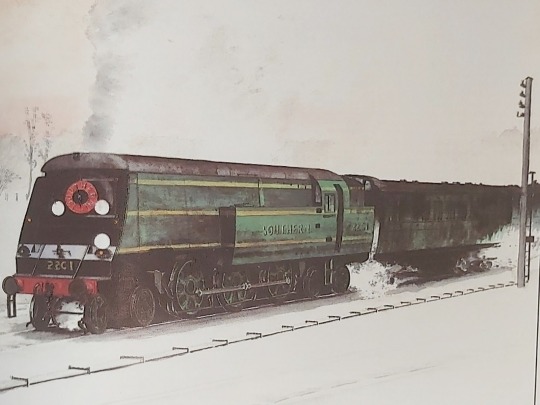
Bulleid designed these locomotives during the Second World War, but construction didn’t begin until 1946. They shared many components with Bulleid’s Q1 0-6-0 goods engines, and were essentially the Q1’s with an Air-Smoothed Casing and a bigger boiler (though the firebox was identical with that of a Q1’s).
Twelve of these engines would be constructed between 1946 and 1948, with the final 3 being built by British Railways. They were originally numbered 22C1 to 22C12, though they were renumbered in 1949 to 36101 to 36112. They were originally meant for short distance goods and passenger services, though they never really found their footing in this role. The passenger trains that usually necessitated big tank engines were already being handled by electric engines, and everything else usually required smaller and lighter engines, which meant that, despite inheriting the power and efficiency of the Q1, the added weight and size meant that they were barred from where they could be most effective. The goods work they were meant for were also in the care of both Q1’s and Maunsell’s Q Class, as well as the many N class moguls already in service. In the end they spent their time hopping from shed-to-shed before settling on ex-LSWR territory, and even venturing into Western Region territory.
They were withdrawn between 1962-1964. Only one survives, 22C9 (36109) on the Bluebell Railway.
Stats
Power Classification - 5F 4P
Built - 1946 to 1948
Boiler Pressure - 230 PSI
Cylinders (2) - 19in x 26in
Wheels (Driven) - 5ft 1in
Wheels (Bogies) - 3ft 1in
Tractive Effort - 30,080 lbf
Southern Railway Dock Class
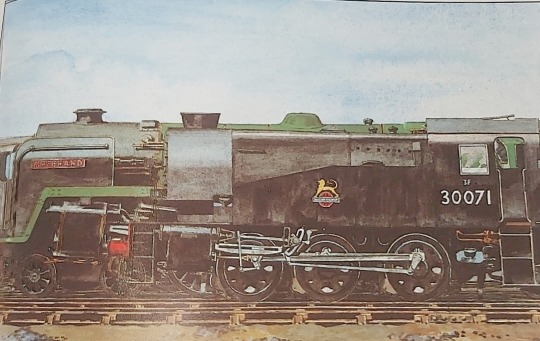
After the Second World War, many of the Southern Railway’s shunters (mainly those at Southampton) inherited from pre-grouping companies were worn out and needed overhauling. As such, Bulleid opted to replace them outright with his own design of 0-6-0T, with a short wheelbase of 10 feet to enable it to negotiate the tight curves. Like many of Bulleid’s designs, he equipped it with a relatively high boiler pressure.
Six would enter service in 1946, and while a total of 18 were planned, this would never come to be, as Eastleigh works was not in a position to build new locomotives with the backlog from the war. In the end, the southern found it cheaper to purchase ex-USATC S100 dock shunters, as they fulfilled most of the requirements needed.
They were numbered C201 to C206, and were renumbered to 30071 to 30076 in British Railways days. The first, 30071, was built with the Idaglass boiler lagging and casing as used in the Q1 class, while the other 5 were built with conventional boiler lagging and tanks. 30071 would be rebuilt like the others in 1953.
The class would lead uninteresting lives as dock shunters in Southampton and Dover until their withdrawal between 1961-1962. One was initially purchased for preservation but the deal fell through. None are preserved.
Stats
Power Classification - 3F
Built - 1946
Boiler Pressure - 220 PSI
Cylinders (2) - 16in x 24in
Wheels (Driven) - 4ft 6in
Tractive Effort - 21,276 lbf
47 notes
·
View notes
Text
Oliver's Reading List for "Ultratrain" Comics
*dusts off the 'ol blog* i think a lot about @mean-scarlet-deceiver's excellent headcanon (from an excellent fic) that Oliver loves comic books. i choose to accept this as reality. but in that case...
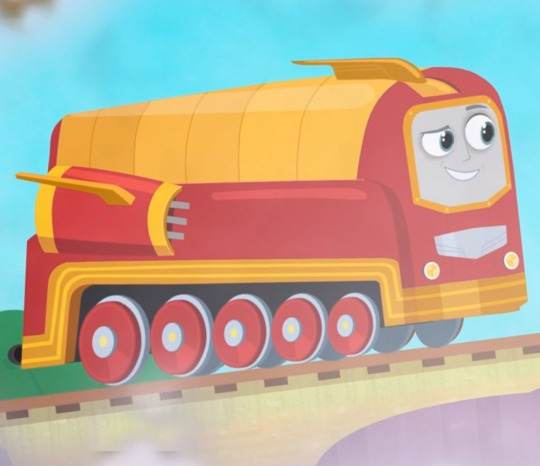
i think oliver would be the number one reader of this guy's book every month as soon as he discovers it. he has strong opinions about every story arc and event crossover and retcon. maybe he gets james really into it too since he seems to be an enjoyer of the whole superhero fare too lol
(also, i chose to believe oliver's favorite 'people' heroes are the X-Men. he wouldn't have had the hardest-hitting stuff while he was on the run since that came about in the mid-late 70s, but he would definitely understand to working hard to help people that don't appreciate him or his kind lol)
#ohhh til something bout#ttte aeg#i like this! headcanon expanded#am convinced oliver spaceman-spiffed his way through tight spots while on the run#isabel's like 'omg how do you stay so calm steam engines normally can't be chill under pressure' and oliver's muttering#narration under his breath as he disassociates his way through the tense moment of the month#ttte oliver#ttte james#5+11#ttte ultratrain#you are. by the way. the third person to use the tag.#fourth post. but third person 🥉#ttte headcanon
8 notes
·
View notes
Text

it's still april even if its not 4/4, so here's four of them!
(derek being d4 was inspired by @.mean-scarlet-deceiver's fic, which you should totally read if you like gordon having character development but still being fundamentally Gordon and derek existing)
#ayyyyyy#gordon towering over the rest <3#i love the detail you put into their clothes#ttte art#ttte humanization#ttte gordon#ttte derek#ttte peter sam#ttte culdee#ohhh to have these four at a table at game night
158 notes
·
View notes
Text
So we all know that Awdry originally had James as a GSWR Class 403 since it fit the description of an inside-cylinder mogul, but later changed James to be an English design. This post stems off the thought of "What If Awdry kept James Scottish?"
This whole thing was also brought on by @mean-scarlet-deceiver's Tales of the G&SW excerpts.
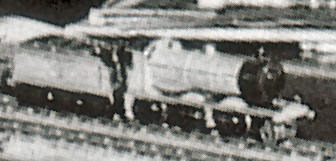
Beware, my writing of a Scottish accent is terrible, try not to cringe.
What If Scottish James
Written By: SparkArrester
1929
James was in a foul mood. Henry, like usual, failed. Now he was stuck with his coal train. That he had to arrange himself. Apparently the new shunter was busy with something that wasn’t shunting.
“Stupid Trucks, stupid coal, stupid everythingggg”, He moaned as he marshalled his train, “All that time being cleaned was a waste!”
The trucks, sensing an opportunity for mischief, made it their mission to give James the worst morning possible. They jammed their brakes, ran hot axles boxes, and some even derailed in the yard. The breaking point was when an old tippler’s front hatch flew open. Coal poured out onto the rails, and onto James, coating his front end. The trucks all burst out laughing, but they were soon cut off.
“Yee wretched little INGRATES!”, Burst out James in a perfect scottish dialect, “Ye all oor jus’ little devious muckle nuisances that are no fit ta scrape ta scale oof me boiler, ye little wee gobshites!”
This continued for some time, until James heard a familiar whistle, and immediately blanched. Percy rolled in looking gobsmacked.
“Err, uhh, hey James?”
“Wha arr ye -ahem- what are, uh, you doing here Percy?”
“Coming to take over the shunting.”
“Ah, right.”
“...”
“... Percy.”
“Yes?”
“Please don’t tell anyone…”
“James, I’m pretty sure everyone on this side of the island heard you.”
“... Dang it.”
1951
James sat there, covered in tar. His crew had already gone to the station to phone for help, and one of the old Suddery Tanks brought a crane to assist. He was hoping for an engine like Edward or Henry to tank him away. In the meantime, quietly grumbling to himself was good enough. In fact, he was so absorbed with himself that he forgot his surroundings.
“Stupid wee muckle nuisances…”, he muttered, “Stupid Toby. If ‘e wasnae a huge prat my red coat wouldnae be in ruins. Honestly, those wee branchline engines are nothing but great big pieces ‘o-”
A ring of a bell broke him out of his thoughts. He jumped back as he realized Toby and Percy were right beside him. He prayed they hadn’t heard him. They did.
“Ark ay Percy!”, Chortled Toby in a terrible Scottish accent, “Whatever isnae that dirty object!”
“That isn’t even how you use isnae…”, muttered James, but of course they took no notice.
They continued speaking in terrible accents all the way to the sheds. James didn’t know if he should be angry at their teasing, or their complete butchering of his old dialect (one he had tried his hardest to shake), so he settled for both.
1959
The Fat Controller had brought a new goods engine to help out. James was glad at first, now someone else could work the pick-up goods while he got more passengers. He had heard that there was something up with the new engine when it had arrived, but he didn’t put much stock into it. Later in the day, he was backing down on what would hopefully be his last pick-up goods in a while when he heard a whistle. A deep-toned whistle that he had not heard in years. James grimaced as a Caledonian steam engine pulled up on the adjacent line, giving him the stink eye.
“Well Well Well…” The Caledonian spat, “A Sou’-West engine. And one of Pee-Wee Drummond’s oven-boxes! Ah hoped we saw the last ‘o ye back ‘ome!”
“The feeling is most certainly mutual!” He replied with vitriol that wasn’t really there. He hoped to leave everything pre-sodor behind. But of course it had found him. At least he still had a slight bad opinion towards the Caledonian, it did him good in this confrontation.
“Ark aye!”, Exclaimed the Caledonian, “Why do ye soond like tha?”
James was taken aback, “Like what?”
“There it is again! Aye Douggie!”
The question of who “Douggie” was got itself answered quickly, when an identical Caledonian engine pulled up besides the first.
“Aye Donnie. What’s up!”
“Wait wait, just let that Sou’-West engine speak!”
James defiantly shut his mouth, but then his crew chose that exact time to ask him something. He replied as quietly as possible. But not quiet enough.
“O Aye!” Exclaimed “Douggie”, “He soonds like a wee sassenach!”
James went red in the face, “Well! I-I-I-”
“Tha accent is ass!” Chortled “Donnie”, and soon “Dougie” joined in.
They continued until James left, his face matching his paintwork. He put a good few months practicing his accent, and it was hard. He now figured out what exactly was up with the new engine: there were two of them, and they both sucked.
#pffftttt#this is james all right#one of pee-wee hammond's oven-boxes! 💀#ttte percy#ttte toby#ttte donald#ttte douglas#ttte james#ttte fic#friends' fic
81 notes
·
View notes
Note
May I humbly suggest FC3 as a steam tram, Bridget as an electric tram ;)
Well, here's a question: If TFC1 and 2 were engines (tank and SB5 Respectively) How well do you think their relationship would be?
I'm not sure what an SB5 is?
I love the idea of Hatts as engines, especially if it's a spontaneous, controlled transformation. But FC1 and FC2's relationship in engine form depends a lot on what you think their relationship is in human form! We really don't know a ton about it to begin with. Much to consider.
31 notes
·
View notes
Text
*looks at Henry’s disrespect towards Edward throughout series 1 with the other big engines* I could easily brush this out of my headcanons… or I could include all of them and make Henry feel the brunt of the guilt the big engines had on Edward…
——
Edward’s Day Out
I don’t know what in the RWS makes it so that The Sad Story of Henry occurs prior to Edward’s Day Out (does the former directly cause the arrival of other big engines (and Gordon?)), but even then, I think it still wouldn’t be out of place for Henry to resent Edward to tip the attention to the only other engine in the sheds that is undermined.
They became friends (relative to the other events) shortly afterward, which could shed the resentment on Henry’s end as they worked together, though I can’t help but feel it could still linger on…
Trouble in the Sheds
These two are on opposing sides of the strike. Henry goes up and attempts to wheesh Edward, then gets wheeshed by his new friend Percy; and now it’s pretty much solidified that Henry does not respect Edward now. Granted, Edward is the blackleg, and Henry has much reason to be dissatisfied with his current workload and condition; but this is not something that Henry normally did when he was upset with anyone on his own up until now. It’s more than enough to put them on awkward terms with each other, at least until the whole thing ends.
Given how Coal later plays out with Edward taking over Henry’s train, it wouldn’t be surprising if this wasn’t the first instance at all in which he did so. Henry has to reflect on his relationship with him— Edward has been nothing but kind and polite to him, and he wanted to wheesh him. What kind of a friend was he?
Edward’s Exploit
Henry is the one who initiates the speculation on Edward’s work performance, with James and Gordon’s additions casting doubt as well. While one can definitely make the argument that Henry and James’s statements are observations, it doesn’t change that they notice his struggling— or that BoCo and Duck say otherwise to all their remarks. Henry was the one who started it all, so he can’t help but feel awkward about how the argument kicked off. Even so, Henry doesn’t express agreement or disagreement when Gordon suggests retirement, though it must be something that weighs on his mind right afterwards— and probably when he waits later on for Edward’s train.
That, and given all the other slights he had done, it would probably have to had culminated into some sort of huge wake-up call for Henry by now. Edward had been helping him from the start— part of the effort that kept him working on the island despite his illness, his attitude, everything. He was a friend. He was also struggling with his own self-esteem and aging— by Lady was Henry a terrible friend.
At some point, a juxtaposing thought also hits Henry—- that if it weren’t for himself, Edward (and Gordon, burst valve and all) probably wouldn’t have been able to get that Express train to the station. It was a group effort for that one. Perhaps the friendship wasn’t as one-sided as he imagined it to be?
But what if Edward had broken down himself out there, right now? What if Gordon was right and Edward just might have to retire?
Or be sent away?
Henry with the special train waited anxiously too…
#is it bad that the last one is making me laugh#laugh in a horrified way but still#i'd never considered before that henry is not only anxious generally#but with the specific edge of 'omg if he DOES fail and is retired i'm gonna have to feel guilty forever'#he'd have to. like. repent. reform...#but all's well it didn't go down that way :)#edward beat the odds and henry gets to merrily continue his characteristic of 'starting shit with no idea how crazy far it's gonna go'#('i'm not moving out of this tunnel')#('did you see him straining')#('i deserve two tenders')#(etc.)#(all the hits!)#ttte analysis#ttte henry#ttte edward#2+3
24 notes
·
View notes
Text
#not voting coz idk :)#but boosting#ttte poll#narrow-gauge is all the rage#hit era hitin' just right
32 notes
·
View notes
Text
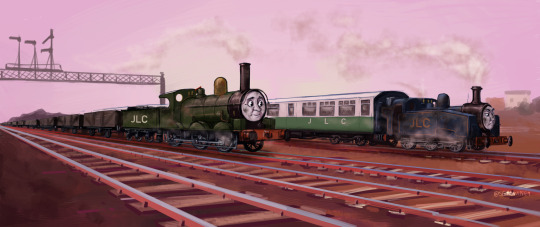
with credit to @/seaswine!
Moss (green tender engine) and Florin (blue tank) are both busy engines in need of a friend.
Well, they are friends. Work just gets in the way.
Tune in for “Watching the Moss Grow,” coming… at some point!
#they're like locomotive godchildren to me :)#watching the moss grow#ttte art#ttte au#real true made-up railways#i love how they look and the lighting is really great! the contrast between the pink-hued sky and the dirty bustle of the railway...#that's some chef's kiss bullshit right there <3
75 notes
·
View notes
Note
Oh!
Well, here's a question: If TFC1 and 2 were engines (tank and SB5 Respectively) How well do you think their relationship would be?
I'm not sure what an SB5 is?
I love the idea of Hatts as engines, especially if it's a spontaneous, controlled transformation. But FC1 and FC2's relationship in engine form depends a lot on what you think their relationship is in human form! We really don't know a ton about it to begin with. Much to consider.
#am i supposed to envision fc1 as a thomassy tank engine#coz that's where i am right now#(in the original post i mean UNCONTROLLED)#(a spontaneous UNCONTROLLED transformation)#(my bad)#i tend to think of topham and charles hatt as tending to butt heads behind the scenes#like fc1 learned to chill tf out but he was really overbearing when his kids *were* still kids. and fc2 is really independent-minded.#charles came back home in the end to become fc2 but i tend to think it wasn't smooth sailing or a foregone conclusion#this is purely headcanon ofc#anyway it would depend on if they could become engines all along or *when* they enginized#it could be a real perspective-changer
31 notes
·
View notes
Note
The talk about Henry’s rebuild has reminded me of my personal headcanon regarding how they turned a failed prototype (or whatever he was - I do like the modified H2 idea) into a Black 5.
Basically, in 1923, the GWR “rebuilt” one of the locomotives from the Vale of Rheidol so thoroughly that none of the parts of the original could actually have fitted on the new engine. In reality, they’d just discarded the old one and started over, but legally it was a rebuild (IDK why - tax reasons or something IG).
I like to think something similar happened to Henry. IIRC the LMS couldn’t actually legally build engines for other railways at the time, so they brought Henry in, Ship-of-Theseus’d him entirely for a Black 5, and then had it written up as a rebuild to get around the rules - and because it was officially a rebuild (or because Stanier knew the engine equivalent of black magic - using some tiny part or some of the metal from the old Henry or something), doing it that way transferred Henry’s consciousness to the new body.
(I don’t like the theories that Henry I and Henry II are entirely separate - I like to think such transfers can happen. In my OC stuff that Vale of Rheidol engine comes up and he also has memories from before his “rebuild” >:3)
Oh that's neat. Stanier as a wizard of death who can use powers for good fits all too well with his history of scrapping engines set aside for preservation...
I'm also not a huge fan of Henry I and Henry II as distinct characters. But the tropes here are catnip - "tax dodge bs" (classic Fat Controller stuff) and "regeneration, with memories from your previous life that pop up at significant moments" (I'm so weak for that stuff).
#what is a tag for the au henrys#ahhh i guess that's it#au henrys#the fat controller#friends' headcanon#ttte henry#chatter#ttte au#where can i read more about your vale of rheidol OC stuff?
18 notes
·
View notes
Note
Well, here's a question: If TFC1 and 2 were engines (tank and SB5 Respectively) How well do you think their relationship would be?
I'm not sure what an SB5 is?
I love the idea of Hatts as engines, especially if it's a spontaneous, uncontrolled transformation. But FC1 and FC2's relationship in engine form depends a lot on what you think their relationship is in human form! We really don't know a ton about it to begin with. Much to consider.
31 notes
·
View notes
Text

In the late 1920s, the Great Western Railway was paying close attention to its South Welsh coal traffic. A Pandora’s Box had been opened by the Great War; ten years after its end, the mining industry was still simultaneously roiled by labor strife and the new issue of competition from other countries who could sell their coal cheaper. Beyer-Peacock was contracted to draw and construct a small number of Garratts, (the GWR leadership was too conservative to build them themselves, although the blue collar rank of Swindon had been eager to try and distraught at being denied,) each of which would do the work of two eight-coupled heavy goods engines. This would cut down on crewing costs and beneficially not require alteration to the existing permanent way.
Six 2-8-0+0-8-2 Garratts were built in a single batch in 1933, hitting the rails just as demand for coal was cratering. Their introduction also meant the redundancy of a dozen or so 4200 Class tanks which already were under scrutiny due to market trends of the day. The Garratts, quickly named “Super Taffys,” were at first resented for their foreignness, but their comfortable cabs and smooth riding quickly won enginemen over.
They survived intact as a class until 1959 when withdrawals began, and never strayed much from their home turf. As a result, they drew trainspotters from the country over to South Wales. A much overpowered double-header Farewell Special was arranged in the summer of 1964, (which worked out beautifully as the class weren’t fitted to steam heat passenger stock,) and these two last survivors were sold right into preservation. This was for the best, not merely for posterity but because Woodham Brothers of Barry Island “couldn’t be buggered” with storing them had they gone for scrap.
#pour one out for the swindon enginemen who just wanted to build something nonstandard. just once.#real true made-up railway stuff#garratt engines
34 notes
·
View notes